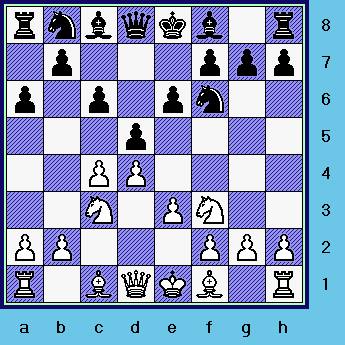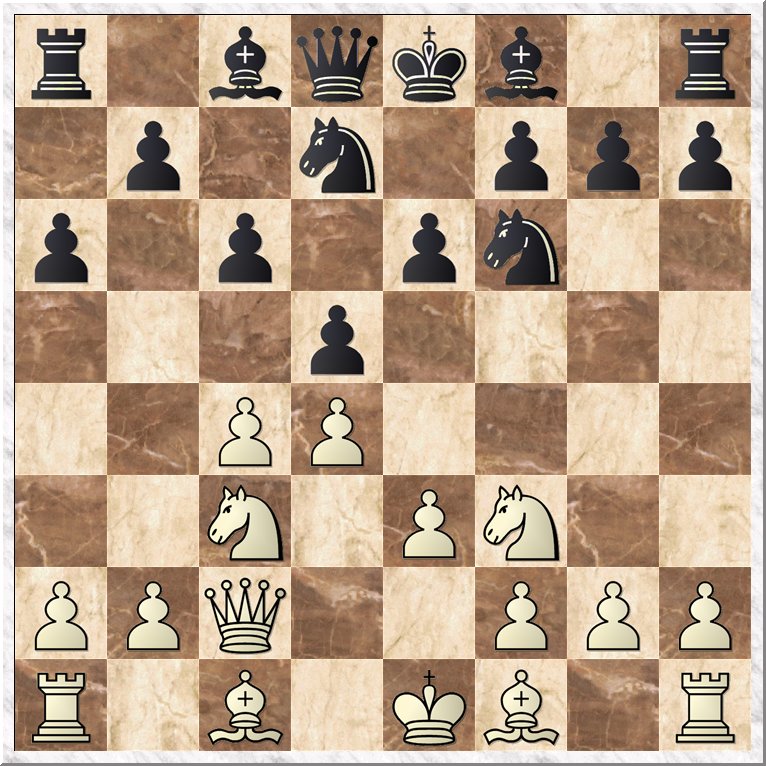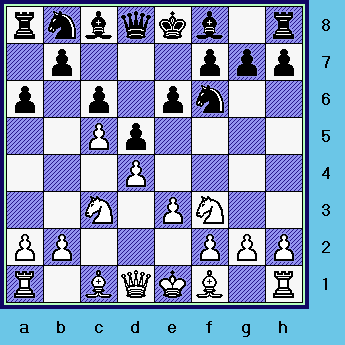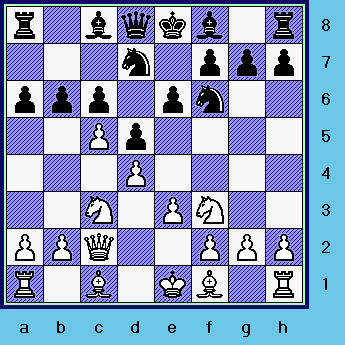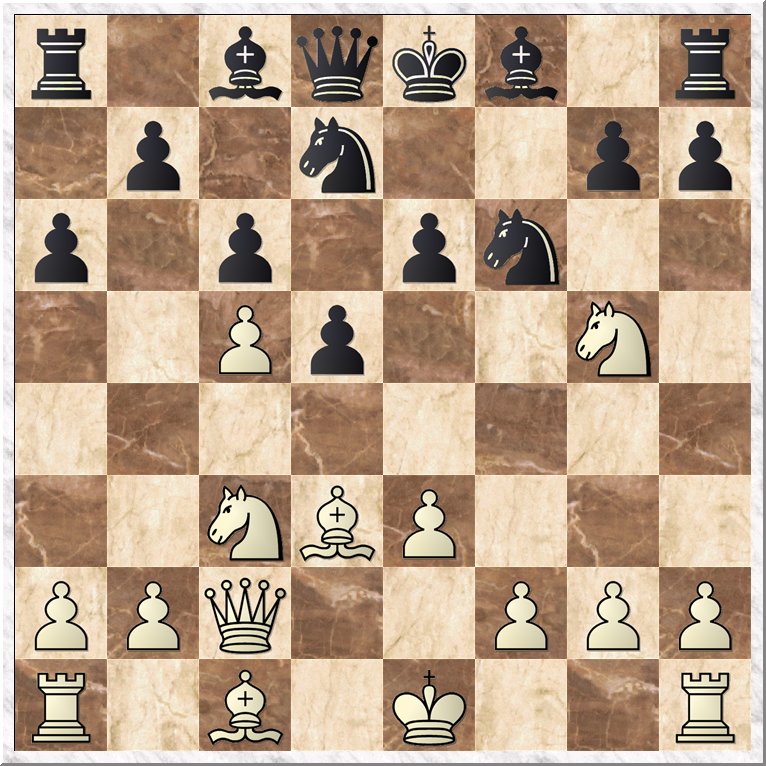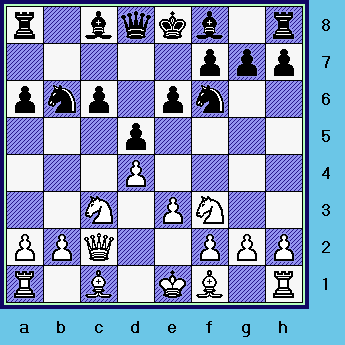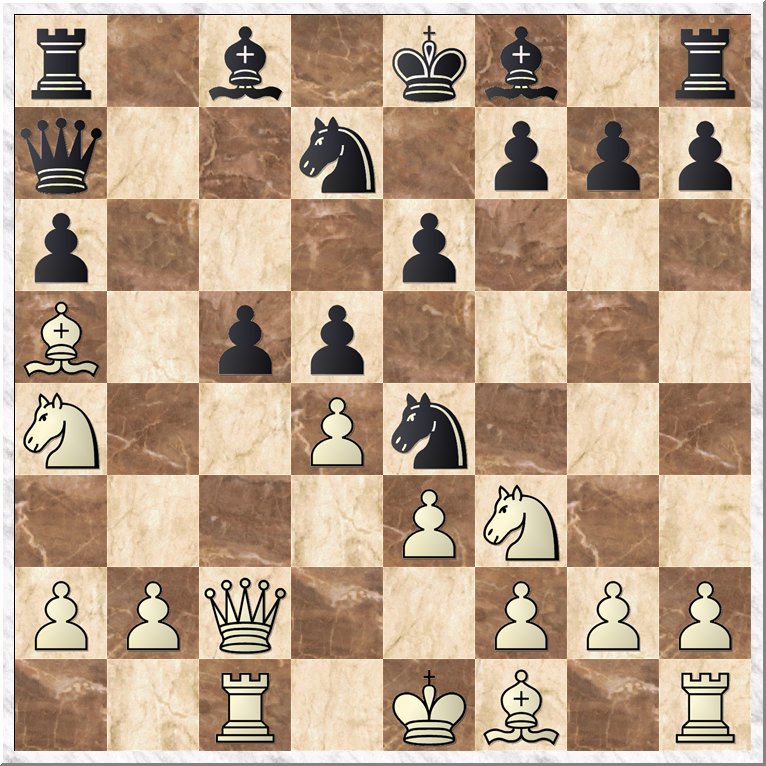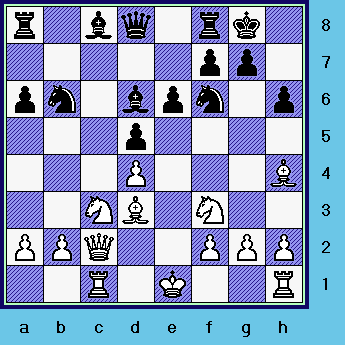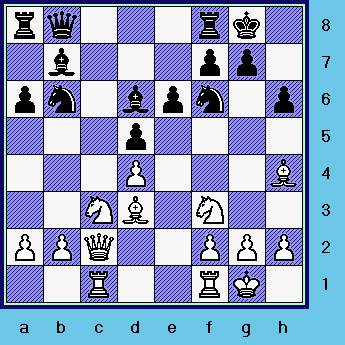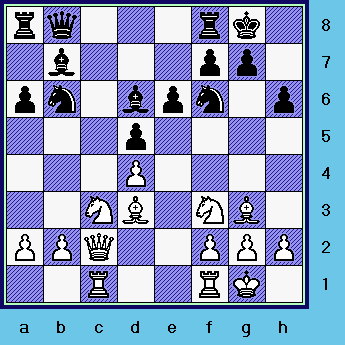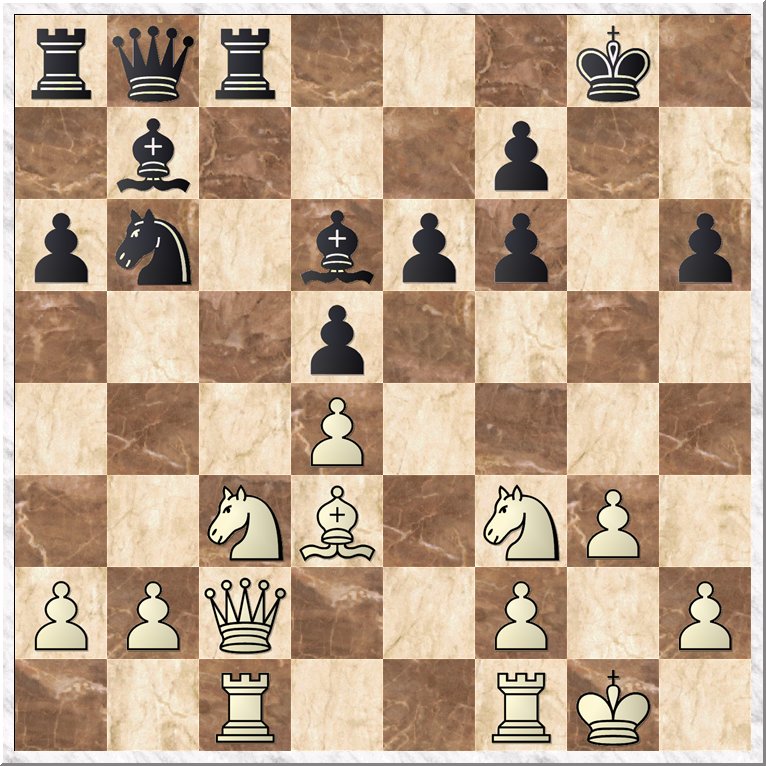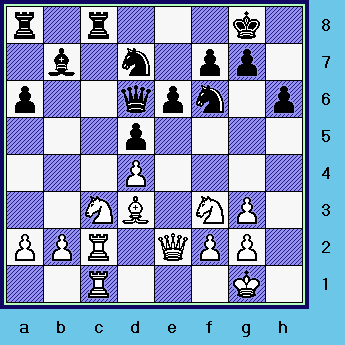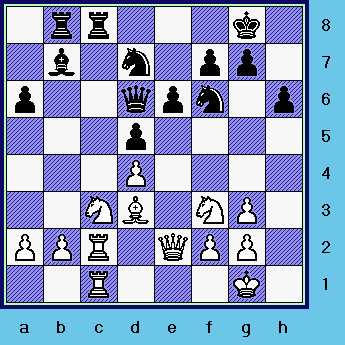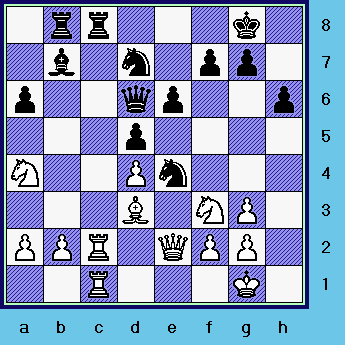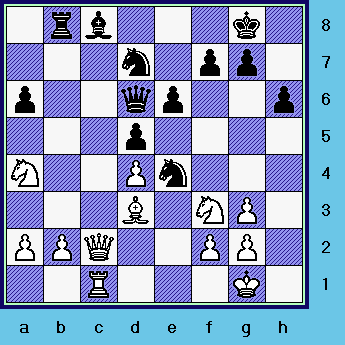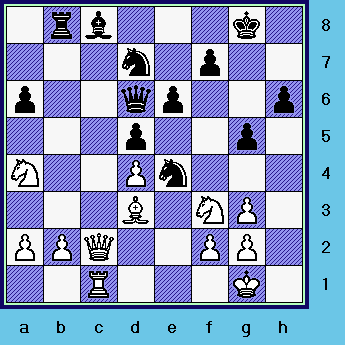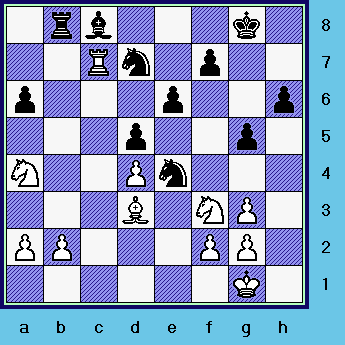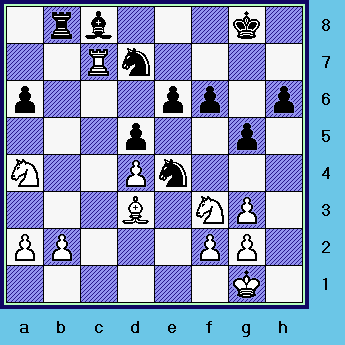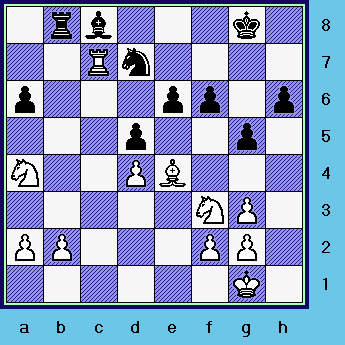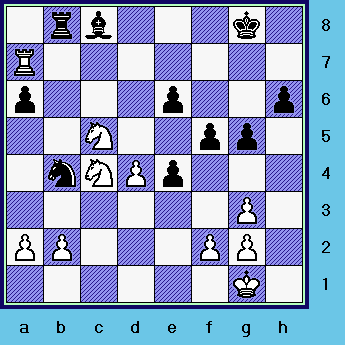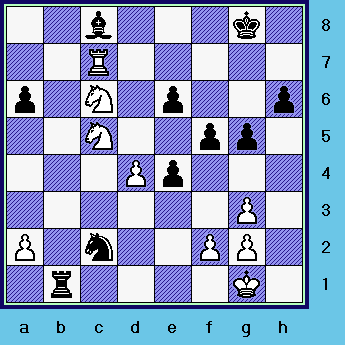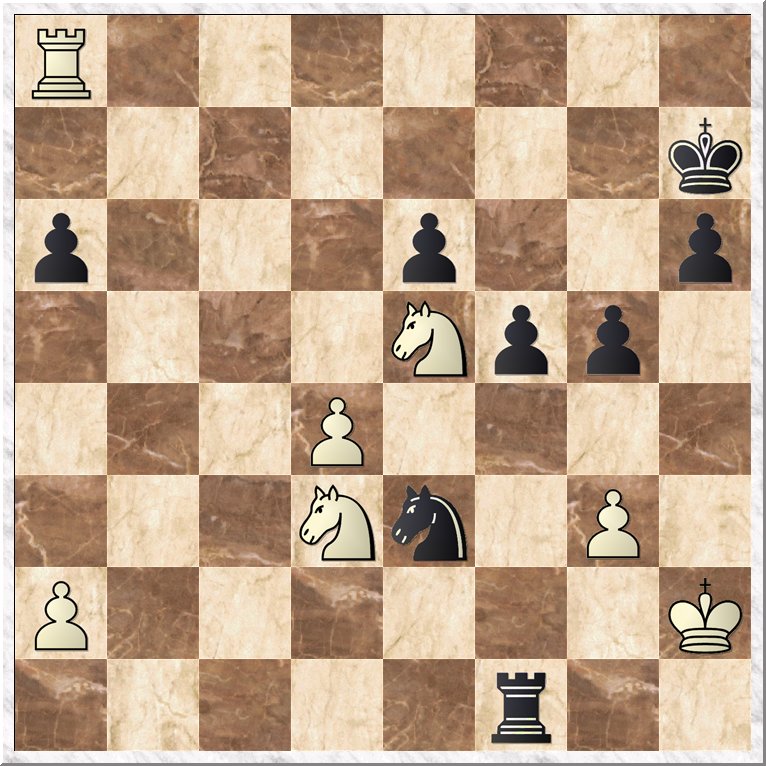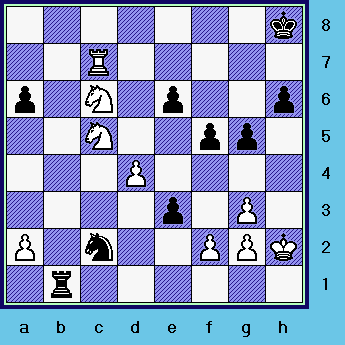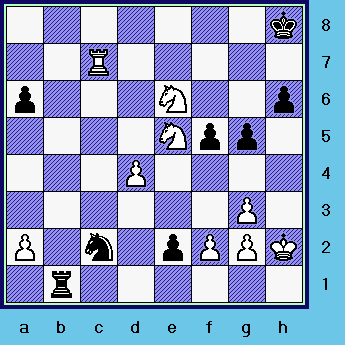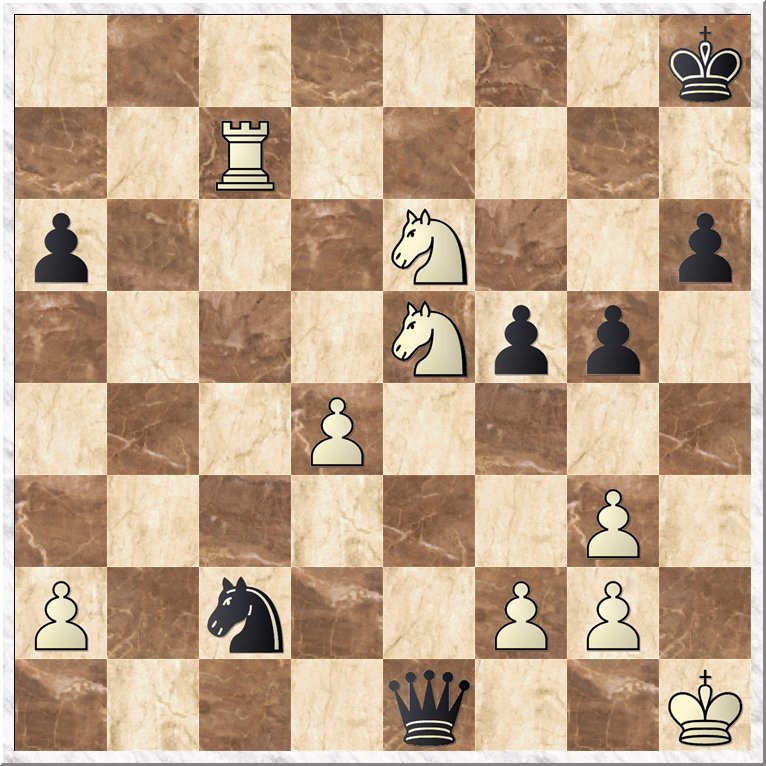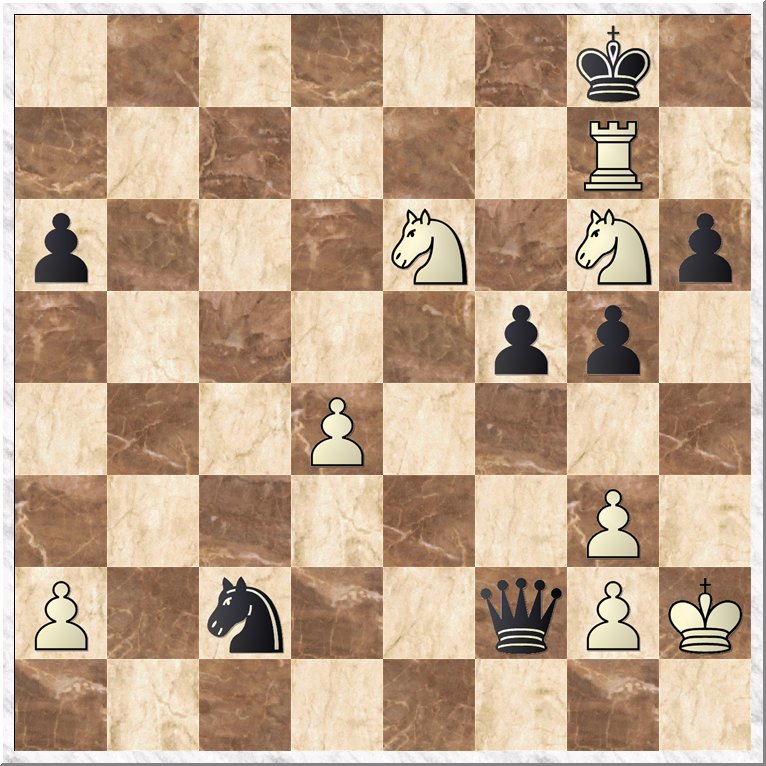All
the |
(Navigation bar
directly below.)
*******
© A.J. Goldsby, 2015.
(All rights reserved.)
****************
Click HERE
to see my
Chess Items.
****************
****************
Buy a book
from Amazon.com
(And help me out as well!)
****************
Click HERE
...
to see a list of the businesses that help to sponsor all of
my chess efforts.
Recent events ...
... taking a look at Game #7 of The 2012 World Championship Match.
|
I decided that I would have to annotate this game ... for several different reasons. Perhaps the most important would be to cover those lines and aspects seemingly ignored by a few of the other pundits and annotators on the Internet. To be honest, they (the other masters) have covered just about all the bases, there were just one or two fine points that I thought I would offer. I also decided that I was in a fairly unique position. I have many friends and students, they monitored sites like The Play-Chess (server) and "The Internet Chess Club." (One former student sent me the transcript of the coverage of the entire game.) I watched the entire game, mostly on the official site. I also reviewed/watched the game on the CG server, (live) they had both Jenny Shahade and Natalie Pogonina as official commentators. Additionally, I had one young man send me the entire CB file of his analysis of this game generated with Houdini 2.0 on his state-of-the-art laptop. (He obviously worked many hours on this file.) And I had friends sending me many text messages, there must have been over a hundred on the game on my cell-phone, plus dozens of IM's and e-mails as well. With all this information, I thought it possible that I could offer insights perhaps not offered before. (I also watched ALL of the on-line video's by masters ... there must have been close to a dozen of them.) I also noticed a certain hasty quality to several of these productions, I strongly felt that a close, thorough look was in order.
************************* NOTE ON THE OPENING: I have a book on 4...a6; and there is a whole section in MCO-15 on 4...a6. (Page # 482.) However, I cannot find this particular opening in MCO-15 at all, neither is it in ECO, not as far as I can tell. (Its not a total loss, I have the chess engines and the "Power-Book" and the games database.) ************************* |
|
Click HERE to see an explanation of the symbols that I commonly use when I annotate any chess game. Click HERE
to replay this game ... on another server. Click HERE to see my video channel on the "You-Tube" channel. (Click HERE to see my YT video on this game.)
GM
Boris Gelfand (2739) -
GM Viswanathan Anand
(2799);
|
|
|
[A.J. Goldsby I]
****************************************************************************************************************************************************************************
This is the first decisive game of
the 2012 World Championships match, I thought that I would take a stab at it and perhaps
concentrate on areas that have
not been touched on by the various other Internet annotators.
(I have spent many weeks working on this game... at one point, looking at the game for almost 24 straight hours! - just after it was played ... I also have used all the latest engines to analyze this particular game; I thought that I would concentrate on just my thoughts and the various moves of the machines and all the chess engines. M. Pein, G. Milos, D. King and also A. Martin have all taken a look at this game already. Many of the moves that I will skip can be found in their analysis; be sure to check out the link {above} and view the analysis and look at the various chess video's.)
****************************************************************************************************************************************************************************
1.d4 d5; 2.c4 c6;
The Slav, although the pure form, (with an eventual ...Bf5); is not seen much in high-level GM chess nowadays.
3.Nc3 Nf6; 4.e3 e6;
5.Nf3 a6; (The plan?)
{See the game diagram, just below.}
All this was seen in the previous game,
(Match
Game #6); remember that the players swap colors in the middle of the match.
(I.e., Gelfand gets two White's in a row and Anand
gets two Black's in a row. I believe that this is done to try
and off-set the
possible edge that one player might get from receiving
White in the first game.)
|
|
rnbqkb1r/1p3ppp/p1p1pn2/3p4/2PP4/2N1PN2/PP3PPP/R1BQKB1R w KQkq - 0 6
5...a6!? is a high-class waiting move, I have written a number of articles on 4...a6; and 5...a6; for various state chess magazines and articles for various websites. (One example - on the WCA website. Also see my "Game of The Month" for January, 2006. ---> Click here.)
---> [ RR For the moves of: 1.d4, d5; 2.c4, c6; 3.Nf3, Nf6; 4.Nc3, a6; See MCO-15, page # 482. ]
[ Black can also play a similar system with: 5...Nbd7; 6.Qc2 a6!?;
|
|
r1bqkb1r/1p1n1ppp/p1p1pn2/3p4/2PP4/2N1PN2/PPQ2PPP/R1B1KB1R w KQkq - 0 7
see the
(following) contest:
GM Magnus Carlsen (2815) - GM Hikaru
Nakamura (2774); [D45]
ICT, 20th Melody Amber (rapid) Monte
Carlo, (R#01) / 12,03,2011.
{White won, 1-0 in 40 moves.} [replay]
]
6.c5, (Exploit
the hole @ b6?)
{See the game diagram, just below.}
Gelfand tries something different than their previous game.
|
|
rnbqkb1r/1p3ppp/p1p1pn2/2Pp4/3P4/2N1PN2/PP3PPP/R1BQKB1R b KQkq - 0 6
( In game Two of this match, Gelfand played 6.b3, and that lead absolutely nowhere, the game was drawn in 25 moves. [more] )
[ The move of: RR 6.Qc2, "+/=" was played in Game Six, and this lead nowhere, and the game was soon drawn. (1/2, 29 moves.) ]
6...Nbd7; 7.Qc2 b6!?;
{See the game diagram, just below.}
A new book (and a DVD) on this opening both claim easy equality for Black. However,
since Anand obviously deeply prepared this line for this match, he may have had a reason for
side-stepping this continuation ... (see the analysis, just below).
|
|
r1bqkb1r/3n1ppp/ppp1pn2/2Pp4/3P4/2N1PN2/PPQ2PPP/R1B1KB1R w KQkq - 0 8
Black tries to immediately open the Q-side, theory seems to prefer the idea that Black should (instead) prepare the ...e6-e5; advance.
[
A critical line was: RR 7...e5!?;
8.dxe5!,
I think that White should open
the game up here.
( After the following <book> continuation here:
8.Be2 Be7; 9.0-0 e4; 10.Nd2 Nf8;
11.f3!, "+/=" White is also solidly better.
)
8...Ng4T;
Forced. ("[]") 9.e6!?,
This is interesting, but its not
White's only good play here.
( Or >/= 9.Na4!,
"+/=" (White has a nice, solid plus.) - GM Tomi Nyback.
(Fritz prefers this, I do as well. I have been working on this line for 2-3 years,
and this is what I would play for White.) )
9...fxe6; 10.Bd3 Ngf6; 11.Ng5, "~" (Unclear.)
|
|
r1bqkb1r/1p1n2pp/p1p1pn2/2Pp2N1/8/2NBP3/PPQ2PPP/R1B1K2R b KQkq - 0 11
... which was the contest:
GM Teimour Radjabov (2650) - GM Alexander
Grischuk (2732); [D10]
ICT, 7th Corsica Masters (rapid)
/ Bastia, France;
(Round. # 1.6) / 01,11,2003.
{Black won, 0-1 in 35 moves.}
[replay]
I think that there are many improvements possible - for both sides - over this game.
(Perhaps more solid is: RR 11.Na4!?, "=" with a long-term Q-side bind. ) ]
8.cxb6 Nxb6!?; (TN = Theoretical
Novelty, or new move.)
{See the game diagram, just below.}
Black plays the first new move of this particular game here.
(This seems justified, as after the older move, White seems
to keep the upper hand.)
|
|
r1bqkb1r/5ppp/pnp1pn2/3p4/3P4/2N1PN2/PPQ2PPP/R1B1KB1R w KQkq - 0 9
It seems strange that Black should be able to nearly gain equality with a second move of this Knight, and it moves the horse to a seemingly inferior square as well ... (Some might try to assign blame to this move, but a careful analysis will show that this was not the play which caused Anand all of his various problems in this game.)
[ The alternative, (coming mostly from the well known and respected "Power-Book"); was the following line:
8...Qxb6!?; 9.Bd2 c5!?; 10.Na4! Qa7!?; 11.Rc1 Ne4; 12.Ba5!, "+/=" (Maybe "+/")
|
|
r1b1kb1r/q2n1ppp/p3p3/B1pp4/N2Pn3/4PN2/PPQ2PPP/2R1KB1R b Kkq - 0 12
when White is clearly better, although there are NO "GM-vs-GM" games in any database that I could find. ]
Now since White is about to
pile up on that vertical file, Black sets about ridding himself of his bad (potentially fatal) backward
Pawn on the half-open c-file.
9.Bd2 c5; 10.Rc1 cxd4;
11.exd4 Bd6; 12.Bg5 0-0; 13.Bd3 h6;
14.Bh4, "="
{See the game diagram, just below.}
So far, both players have played well, there is no doubt that all parties had looked at similar
ideas in their home analysis.
|
|
r1bq1rk1/5pp1/pn1bpn1p/3p4/3P3B/2NB1N2/PPQ2PPP/2R1K2R b K - 0 14
Thus far, the position is equal.
[ </= 14.Be3!? Bb7; "=" ]
Now Anand plays:
14...Bb7!?;
This is OK, but the box shows that Anand missed a much better move here. (See below.)
[ After the continuation of:
>/= 14...Bf4!; 15.Rd1 Nbd7;
16.0-0 Bb7; 17.Rfe1 Qc7;
18.Bg3 Bxg3;
19.hxg3 Rfc8; "=" Black has no problems.
]
15.0-0 Qb8!?; (hmmm)
{See the game diagram, just below.}
Anand plays enterprising chess, several on-line commentators were
praising this play as a move, ...
"that steals the initiative."
(The engines prefer ...Bf4; or ...Nbd7; here for Black.)
|
|
rq3rk1/1b3pp1/pn1bpn1p/3p4/3P3B/2NB1N2/PPQ2PPP/2R2RK1 w - - 0 16
Of course, the engines see things a whole lot differently, and now White can capture on the f6-square.
16.Bg3!, (positional)
{See the game diagram, just below.}
Of course, Gelfand saw the capture on f6, and eventually rejected it, as this conforms to his overall style.
|
|
rq3rk1/1b3pp1/pn1bpn1p/3p4/3P4/2NB1NB1/PPQ2PPP/2R2RK1 b - - 0 16
There was a huge outcry on the Internet, and many players were just (virtually) screaming that White should capture on f6.
For the record, I will only make two observations about this:
#1.) If you have an engine by your side, you are free to play any line that you like, and you will always make the best move,
and you are free from problems like time pressure and the worry that you might make an error. However, in real (OTB) play,
things are a lot different and you must play what you believe is best and also what conforms to your own personal tastes.#2.) White is simply better, because of Black's bad QB, and Bg3 highlights this fact. If you capture on f6 ...
and don't win ... then you will find out that it may have been unwise to open the g-file, give your opponent the Bishop pair,
to lose a great deal of dark-square influence, and also (perhaps permanently) deny your Knights the e5-square as a
valuable, long-term outpost.
"If White plays Bxf6 he will lose control of
the dark squares and there is no clear way to attack the Black King."
-- GM Gilberto Milos. (On
ICC ... and also the ChessBase website, see the link at the top of this
page.)
[ After the moves: RR
16.Bxf6 gxf6; 17.g3,
"+/=" (White has a solid edge here.)
17...Rc8; "<=>" ({and}
Black has good piece play.)
|
|
rqr3k1/1b3p2/pn1bpp1p/3p4/3P4/2NB1NP1/PPQ2P1P/2R2RK1 w - - 0 18
White is better, but Black may have some real counterplay. (Based on the Bishop pair, and also the half-open g-file.) ]
Now Black finds himself unable to successfully untangle his position- or get counterplay - which may be the best argument for Gelfand's 16th move.
16...Rc8;
This is OK ... ... ...
... but perhaps Black should have doubled White's pawns as quickly as possible.
[ The machine prefers: RR
16...Bxg3; 17.hxg3,
"+/=" 17...Nbd7;
and White only has a very minimal edge here.
]
17.Qe2 Bxg3; 18.hxg3 Qd6;
Black must untangle a bit, most of the engines see this move as the correct way to go.
19.Rc2 Nbd7; 20.Rfc1,
"+/=" {See
the game diagram, just below.}
White is solidly ... just a little better here ... ... ...
|
|
r1r3k1/1b1n1pp1/p2qpn1p/3p4/3P4/2NB1NP1/PPR1QPP1/2R3K1 b - - 0 20
... however, White's position is a LONG way from being winning! (This must be the crucial position.)
**********************************************************************************************************************************************************************
Now in a space of just a handful of moves, the wheels literally fall off GM V. Anand's wagon here.
20...Rab8?!; (Definitely inferior.)
{See the game diagram, just below.}
After the game, Anand himself was openly critical of this move, and the engines agree with him!
(The on-line pundits have already deeply analyzed many of the key variations here, so I will not bother.
In particular, IM A. Martin
deeply looks at all of the alternatives here, all you have to do is
click on the link,
and then watch his video. {This is
excellent work, by the way!})
|
|
1rr3k1/1b1n1pp1/p2qpn1p/3p4/3P4/2NB1NP1/PPR1QPP1/2R3K1 w - - 0 21
Again ... for a detailed analysis of Black's various alternatives, see any of the previously mentioned internet articles or video's.
[ >/= 20...Rc7; - Fritz 13. (or ...) >/= 20...a5; - Deep Shredder. ]
Now most of the chess programs - of the many that I tested - all like
>/= 21.Qe3, "+/=" here for White.
21.Na4!?, (Maybe - '!')
Gelfand knows that he is better on the Q-side and therefore pursues his play in that arena.
[ During the game, I was looking at the move of: RR 21.Ne5, "+/=" (square / outpost) which is also good for White. ]
21...Ne4!?; (Maybe - '?!' or '?')
{See the game diagram, just below.}
Once more, Anand plays a move that looks good on the surface, but may not be the most accurate.
|
|
1rr3k1/1b1n1pp1/p2qp2p/3p4/N2Pn3/3B1NP1/PPR1QPP1/2R3K1 w - - 0 22
To add to his other woes here, Anand was slowly running down his time on his clock, as well.
[ Definitely an improvement was:
>/= 21...Rxc2!; 22.Rxc2 Ne4;
23.Qe3, "+/=" ( - Fritz
13.)
and although White has a solid edge here, Black may yet be able to defend.
]
22.Rxc8+! Bxc8[]; ("T" or forced.)
Black has to play this ... (see the line - just below).
[ Instead, after the continuation of:
</= 22...Rxc8?!; 23.Rxc8+ Bxc8;
24.Bxe4 dxe4; 25.Qxe4, '±' ("+/"
White is much better.)
all Black has done is to drop a Pawn ... and will probably lose the endgame.
]
Now all the machines prefer 23.Qe3!, here.
I think the idea is just Qe3-f4, swap the Queens, stick a N (knight) on e5, centralize the King; and White has a much superior endgame from there.
**********************************************************************************************************************************************************************
23.Qc2!?, {See
the game diagram, just below.}
The simplest?
|
|
1rb3k1/3n1pp1/p2qp2p/3p4/N2Pn3/3B1NP1/PPQ2PP1/2R3K1 b - - 0 23
Gelfand was also using a lot of time here, and opts to remove BQ and place his Rook on the seventh rank, which cannot be a bad idea at all.
[ Or RR 23.Qe3!?, - Fritz 13. (See the explanation of the possible connected ideas ... just before White's 23rd move.)
**************************************************************************************************************************
Instead, after the following line: </= 23.Bxe4!? dxe4;
24.Qxe4 Bb7;
25.Qe3 Bc6!; "<=>" (counterplay)
White has won a Pawn, but Black will probably get it back -
with an OK position. ]
23...g5?; (Positional disaster!)
{See the game diagram, just below.}
Black gains space?!?!?
|
|
1rb3k1/3n1p2/p2qp2p/3p2p1/N2Pn3/3B1NP1/PPQ2PP1/2R3K1 w - g6 0 24
This looks like a beginner's move, if I had not been watching the game myself, I might have had a hard time believing that Anand actually played this move!
(It wrecks his King-side, grossly weakens his Pawns, etc.)
[ Both Fritz and Houdini (and several other strong engines) recommend that Black should {instead}
play the following variation here:
>/= 23...Bb7; 24.Nc5 Rc8;
25.b4 Qb6; 26.Qb1,
"+/="
when White has a fairly large edge, yet a clearly winning line is nowhere to be found.
]
Now White had many (good) options on this move ... (Qc6, b3, Kf1, etc.)
... but plays the move that is both the simplest, the strongest ... and the engines concur that it is the best.
24.Qc7! Qxc7; (hmmm)
Anand thought for a bit here, and I think that you could begin to see that he knew he was in trouble.
I think here Anand begins trying to find a tactical solution to his problems, which is what he did as a youth in chess.
[ The metal monster recommends:
RR
>/= 2 4...Bb7; 25.Bxe4 Qxc7;
26.Bh7+! Kxh7; 27.Rxc7 Bc8; 28.Nc5!,
'±' ("+/" or with an advantage to
White.)
and White should
(probably) eventually win from here, although its not 100% certain.
]
25.Rxc7, '±' ("+/"
... Maybe "+-")
{See the game diagram, just below.}
White is clearly much better ... (and possibly winning here).
|
|
1rb3k1/2Rn1p2/p3p2p/3p2p1/N2Pn3/3B1NP1/PP3PP1/6K1 b - - 0 25
Yet I maintain, that while somewhat esoteric, Anand did not play the best defense from this position, either.
25...f6?!; (Maybe just - '?')
{See the game diagram, just below.}
It's hard to be too critical of Anand, yet if you are going to sit there and continue to play, don't you have a moral obligation to try and play/find the best possible moves?
|
|
1rb3k1/2Rn4/p3pp1p/3p2p1/N2Pn3/3B1NP1/PP3PP1/6K1 w - - 0 26
Rather than this turkey of a move, (which has the unfortunate effect of trapping the BK on the first rank); Anand could have played 25...Kf8; or 25...Nef6; or 25...Nd6. (Or possibly just about anything other than the move that he actually played here!)
Maybe the ONLY good thing I can say about 25...f6?; is that it makes Boris Gelfand look like a tactical genius in this game!
[ The iron giant (Fritz) prefers the following line here:
>/=
25...Ndf6; 26.Ne5 Nd6; 27.b3,
'±' ("+/" maybe "+/-")
when White has a huge advantage ... according to all of the chess engines ...
yet the material balance remains equal, at least for the moment.
(Analysis line by -
Fritz 13. Houdini 2.0 ... running on the official website, {Aquarium};
gives only 25...Ndf6; 26.Ne5, and ends with the following evaluation.
{"+0.78|d21"}.) ]
26.Bxe4!, (Simplest and best.)
{See the game diagram, just below.}
White chooses the most forcing possible move ... and it is also the one that is probably best.
|
|
1rb3k1/2Rn4/p3pp1p/3p2p1/N2PB3/5NP1/PP3PP1/6K1 b - - 0 26
However, this was not the only move here, serious consideration was due to several ideas, (see the analysis just below).
[ Instead, by playing these moves:
RR 26.b3 Kf8;
27.Bxe4 dxe4;
28.Nd2 f5; 29.Nc5 Nb6; 30.Rh7,
"+/-" (decisive)
and White will win at least two Pawns while allowing almost zero counterplay.
]
[The next series of moves is all best, Gelfand gets the exclams because he refuses easy/passive lines that might win, but instead always goes for the most aggressive/forcing continuation.]
26...dxe4; 27.Nd2 f5;
28.Nc4! Nf6; 29.Nc5! Nd5;
30.Ra7 Nb4!?; (hmmm)
{See the game diagram, just below.}
An interesting idea ...
|
|
1rb3k1/R7/p3p2p/2N2pp1/1nNPp3/6P1/PP3PP1/6K1 w - - 0 31
Anand actually finds an amazing line ... he manages to sacrifice a piece and yet achieve real counter-play, a lesser player (or maybe someone with less time on their clock) could have been overwhelmed by the maze of tactics that follow from this move.
[ Also, after the variation: RR 30...Rb4; 31.b3, "+-" White is obviously winning. ]
I gave Fritz 13 an hour here, and it liked 31.Nd6, for White.
31.Ne5 Nc2!?;
Anand decides that everything (e.g. 31...Nd5); is losing and goes for the aforementioned variation ...
which is great fun gives us a real reason to continue to watch the game.
32.Nc6! Rxb2; 33.Rc7 Rb1+!?;
{See the game diagram, just below.}
This is interesting, but ...
|
|
2b3k1/2R5/p1N1p2p/2N2pp1/3Pp3/6P1/P1n2PP1/1r4K1 w - - 0 34
The machine prefers 33...e3; here, see the analysis below.
[ Maybe a better - and much more complicated - chance might have been for Black to select the following line:
RR 33...e3; 34.Rxc8+ Kh7; 35.Rc7+ Kh8T; Forced.
(Black gets mated or has to shed a great deal of material ... in the following continuation:
</= 35...Kg6?; 36.Ne5+ Kh5;
37.Kh2 g4; 38.Nxe6 Nxd4;
39.Nf4+ Kg5; 40.fxe3 Ne2!?;
41.Rc6 Nxg3; 42.Nf7+ Kh4;
43.Rxh6+ Nh5; 44.Rxh5#.)
36.fxe3 Nxe3; 37.Ne5! Rxg2+;
38.Kh1 Rf2; The best move.
(Going for the perpetual against the rather exposed White King.)
( Much worse would be:
</= 38...Rxa2?; 39.Ng6+ Kg8;
40.Nxe6 Ra1+; 41.Kh2 Ra2+;
42.Kg1 Ra1+; 43.Kf2 Ng4+;
44.Ke2 Ra2+; 45.Ke1 Ra1+;
46.Kd2 Ra2+; 47.Kc1 Ra1+; 48.Kb2, "+-" (Winning.)
when Black has run out of any really useful moves. )
(White's next move is nice, it creates a kind of mini-fortress, with the two Knights protecting each other.
This is the kind of thing to do in
OTB chess, especially if you are short of thinking time on the clock!)
39.Ncd3! Rf1+;
40.Kh2 Kg8;
41.Rc8+ Kh7; 42.Ra8, "+/-" (White
has a winning advantage.)
|
|
R7/7k/p3p2p/4Npp1/3P4/3Nn1P1/P6K/5r2 b - - 0 42
White is winning easily, there is no perpetual. (The first player just gobbles up the RP and then
runs in his own passer ...
for the
full point.)
]
34.Kh2 e3; 35.Rxc8+ Kh7;
36.Rc7+ Kh8T; ("[]" = Forced.)
{See the game diagram, just below.}
This was the only playable move here for Black.
|
|
7k/2R5/p1N1p2p/2N2pp1/3P4/4p1P1/P1n2PPK/1r6 w - - 0 37
This is the current position, we are heading for a most exciting type of finish.
[ Worse would be: </= 36...Kg6?; 37.Ne5+ Kh5; 38.Nxe6 Rh1+; 39.Kxh1 g4;
(Or RR 39...e2; 40.Ng7#.)
40.Rg7 exf2; 41.Nf4#, and Black has been mated. ]
(Now Houdini likes 37.Nd7!
Of course, just about everything is winning here for White.)
37.Ne5! e2; 38.Nxe6!,
"+/-" {See
the game diagram, just below.}
Anand Resigns.
|
|
7k/2R5/p3N2p/4Npp1/3P4/6P1/P1n1pPPK/1r6 b - - 0 38
There is a mate threatened, and the only way to stop it is to play "give-away," something even Anand cannot do - not at this level.
Copyright (c) A.J. Goldsby, 2012. All rights reserved.
[ Black gets a Queen after:
38.Nxe6 Rh1+; 39.Kxh1 e1Q+;
but he is still lost.
|
|
7k/2R5/p3N2p/4Npp1/3P4/6P1/P1n2PP1/4q2K w - - 0 40
For example:
40.Kh2 Qxf2; ('!?')
(Black needs at least one extra move to get out of the mating net that he finds himself in.
I think that all the machines recommend that Black play 40...QxN/e5; here, so as to get out
of the mate. Of course, Black should resign before playing such a move at this level of chess ...)
41.Ng6+ Kg8; 42.Rg7#.
|
|
6k1/6R1/p3N1Np/5pp1/3P4/6P1/P1n2qPK/8 b - - 0 42
It is an amusing <possible> final position. (Black is actually "+1," yet still loses horribly.) ]
1 - 0
The (FIDE) 2012 World Championship (Match)May 10th - to May 30th, 2012: In Moscow, the match is taking place to decide who is the World Chess Champion. GM Vishy Anand is the Champion, and his challenger is GM Boris Gelfand. The match is to be 12 regular games, with tiebreaks to be played if needed. (Of course, we now know that Anand won one game of the tie-breaker ... to retain the title.)
|
The analysis for this page was prepared with the excellent program, ChessBase 10.0. (I also used MANY chess engines!)
The HTML was polished with several different tools and programs, (mostly FP) ... the text was checked for spelling with MS Word.
The diagrams were created with the program, Chess Captor 2.25.
|
Go ... or return ... to my Home Page for this site. Go (or return) ... to my "Annotated Games" (II) Page. Go
... or return ... to my "Best Games"
Page. *******
Copyright (c)
LM A.J. Goldsby
I ******* This
page was first generated in: May, 2012. (Posted:
(late) May,
2012.) Final format
completed on: Friday, June 22nd, 2012.
|
